What To Do
For a visit around town you do not NEED a guide if you have a decent map. However, many people find that a good guide can vastly improve the visit by adding history and cultural insights to what they are seeing. So do not dismiss a guide out of hand. The important thing is to find a good one, who knows the history and enjoys sharing it. See the section on guides for recommendations.
Historical Sites:
The Mosques The three oldest mosques in town are of fascinating architecture and history.
Djingere Ber, meaning Big Mosque in Songai, was the built in 1325 by Ibrahim Abû Ishaq Essaheli who receved 40.000 mitqals of gold from the hands of Mansa Elhadj Kanka Moussa (mansa means king; el hadj means he completed the pilgamage to mecca). After Kanka Moussa's conversion to Islam and pilgrimage to Mecca he returned with a large number of learned people including the architect for the mosque. This changed the style of mud construction in Timbuktu forever.
This mosque has two minarettes, 25 rows of north-south pillars and 9 east-west. These massive collums, the interior courtyard, and pirnicple minarete are charachteristic of the sudaniane architechtural style. Inside are the tombs of several of the saints of Timbuktu. There is also a room for solitary confinement of the devout who wish to isolate themselves in prayer. Another door hidden behind a mat is in fact invisible and untouchable. The legend has it that this hole was caused by a magician transformed into a hyena when forced to listen to the Imam preach and burst through the wall at this spot to escape the pain of the sacred words. The square box-like addition on the west side of the mosque with a little window is a tomb of saints where the devout stop to pray and ask for intervention with God for their problems. This mosque has been listed as a World Heritage Site in Peril since 1989 and has thus benefited from a safeguard project co-managed by the UNESCO centre for world heritage and the minister of Culture. No longer open to the public, it is still worth a look at the outside for the sheer amazement that a mud building can be standing after close to 700 years!
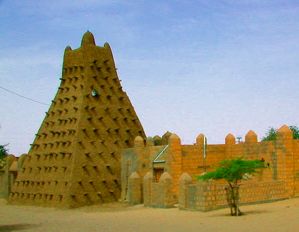
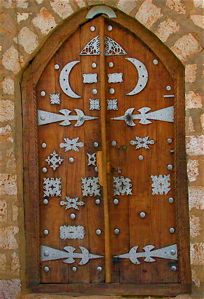
A mosque is open to any believer who wants to enter and pray regardless of his wealth or social status. Legend has it that an unknown homeless man once entered this mosque and stayed for many months in the back dark corner. He was carving holes in the wall; some of the people went to the Imam, Sidi Yahya, hoping to evict this guy who was clearly crazy. The Sidi Yahya replied that it was the house of God. It wasn’t for him to kick someone just because he did not understand what he was doing. Most of the world's great works have been performed by people thought to be crazy. They should be patient. Finally the unknown man came one day to the elders and spoke saying he would show them the stars at mid-day. Everyone knew this was impossible but that day they showed up before afternoon prayer. This man took them back to the dark corner of the mosque and unveiled his work. He had pierced hundreds of holes in the wall in the exact spots of the constellations and the sun shining through showed them up like the night sky, the man was the greatest scholar of astronomy at the time. The doors are a representation of this work
Also in this mosque is a set of double doors. The “secretes” or talisman of the mosque, are locked between the doors for all time and superstition has it that if the doors are ever opened it will bring about the end of the world.
Long before any European set foot in Timbuktu rumours had been coming to them of this fabled city. It may seem hard to get to now, but that is nothing compared to a few centuries ago. The first few explorers to make it have been immortalized, the homes they stayed in turned into shrines or at the very least a plaque is put up in commemoration. For those who have read the writings of these men or imagine travelling like them, standing outside their homes or visiting the small museum inside can have the feeling of a pilgrimage.
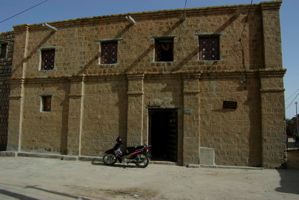
In 1825 Alexander Gordon Laing a major in Britain's Royal African Corps, was commissioned to go to Timbuktu. Having recently befriended the English Consul in Tripoli and married his daughter, Laing promised to return in five months. He left Tripoli in July and headed directly across the Sahara in strict military uniform which is probably what got him attacked by Tuaregs and left for dead. Finally in August of 1826 after more than a year of solitary travel having lost all of his retinue on the way (the only one who didn’t die went back to Tripoli) Laing arrived. He was the first European to do so and made so many notes and inquiries that he angered the local inhabitants who kicked him out 40 days later. He was assassinated on his way out of town, apparently by some of his own guides. They cut off his head and burnt his notebooks, so nothing remains of all the information he gathered, save the few letters he managed to send to the consul in Tripoli. Britain accused the French consul of having acquired the notes, causing a diplomatic incident that resurfaced several years later when René Caillié published his account of his trip to Timbuktu. A plaque on the house he inhabited in Timbuktu says "To the memory of Major Alexander Gordon Laing 2nd West India Regiment. The explorer who at the cost of his life reached Timbuktu in 1826. Erected in his memory by the Royal African Society in 1963”

He was followed by René Caillié a Frenchman hoping to win the Geographic Society Monetary Prize of 10,000 francs offered for the first man to come back with a description of Timbuktu. He spent a year learning Arabic, and Muslim customs and language. Then, disguised as an escaped captive wishing to return home, he spent another year travelling from Senegal and made it to Timbuktu in 1828. Learning of the fate of Gordon Laing who preceded him, René Caillié felt ill at ease in Timbuktu. He stayed a only two weeks, leaving at the first opportunity to present itself. He only wrote one chapter about the town and that rather unflattering, considering all the writings of Arab explorers of the 14th century who waxed eloquent about the town’s prosperity and thriving commerce. Upon his return he was decorated with the cross of a knight of the legion of honour by the Parisian Geographic Society. One hundred years after his arrival in Timbuktu, his cremated remains were transported across the Sahara and interred in the house he inhabited there. His home was recently renovated in an effort to preserve it, being named a national patrimony site.
The German explorer Henrich Barth, was something of a genius, he spoke six languages including Arabic and had already travelled extensively in north Africa when he joined a group sent by the British to open communication with black Africa. Of the three men that left Tripoli in 1850 Barth was the only survivor after two years of travel in the desert. He continued to explore and take notes on culture, environment, botany and geography. He arrived in Timbuktu under the name of Abdel Krim lived here from 7 September 1853 to May 1854, where he continued to take notes. It was he who confirmed and completed René Caillié’s description of Timbuktu. Barth had his life repeatedly threatened during his stay but the chief Kounta Sidi El Bekay protected and hid him in his camp each time. Barth took 15 months to get back and wrote five volumes on his travels, which remain unequalled in its richness of content and value to science and geography. He received the golden medals of Berlin’s, Paris’, and London’s geographic societies. The house he lived in in Timbuktu, in the Bajinde neighbourhood, has a bronze plaque above the door, inagurated in 1966 by the president of the R.F.A. The house was restored in 1992 with aid from Germany and been transformed into a museum with a well documented exhibit in English, French and German languages. For those who are interested in the era of great explorers it is worth a visit. If you show up they well fetch someone who lives in the house with a key to let you into the exibit room, they may also alow you to visit the rest of the house or climb to the rooftop; 1000f entry fee.
The home of the Austrian explorer Oscar Lentz is also marked, though certain local historians say that the plaque is actually on the home facing his, his is tumbling to ruin. Relatively unremembered, he was the next to reach Timbuktu, 26 years after Barth, on the 1st of July 1880. He stayed only a short time and apparently had no troubles worth mentioning. He was well received and made friends with the Tuareg chiefs, thus opening new lines of communication especially between Medine and Timbuktu. He also wrote extensively, documenting changes since Barth’s visit
One other home is marked that of Berkey, It is directly across from the municipal museum and bears this plaque. “to the memory of D.W. Berkey leader of the first American Trans-Sahara expedition Biskia to Timbuktu. October 29 1712 - May 12, 1913. Erected in his honor by members of his family November, 7 1979.”
The surprising thing in reading the works of these intrepid explorers is not how much has changed in two hundred odd years. Rather how much has stayed the same. Here are some excerpts that if you come visit you can test for authenticity:
In every direction one sees only immense plains of moving sand, of white on yellow, and of the greatest aridness, […] the sky at the horizon is a pale red
-René Caillié’s description of Timbuktu in Journal d’un Voyage à Tombouctou
The camp offered, especially in the morning, an animated look. The two large magnificent cotton tents of the cheik, hung with a blanket in black and white squares and a curtain of wool, were half open to allow the fresh morning air to circulate in the interior; around the huts on all sides are groups of camels, cattle, and goats. […] In the evening, one saw herds returning from pasture, donkeys, driven by slaves, bringing water, and the pious students of the cheik, grouped in a sort of auditorium around a thorn tree and guided by the sonorous voice of their master, learn their prayers by heart...
-Henrich Barth’s description of cheik el Bakay’s camp;
except of Voyages et Découverts dans l’Afrique septentrionale et centrale
Timbuktu is really only a big market, a meeting place of negotiators, who exchange products from the north for those of the south. […] It is a depot of merchandise: Touareg and Fulani constantly dispute who has the right to collect taxes without governing the town. It is administered to only by el-Kahia, whom one can only consider as a mayor. As long as this state of affairs continues Timbuktu won’t be able to prosper.
-Oscar Lentz, 1880
The shops of cotton cloth merchants are numerous. The fabrics of Europe also arrive in Timbuktu brought by Berber merchants.
-Leon African, 1507
One sees here, in clothing, some large tobas of the south, either in European cotton, very simple and of poor quality, or in indigenous cloth, this fairly rough, but excellent: it is woven in strips a handbreadth wide, which are then sewed together. The tobas made of this fabric, and died indigo, are often garnished with very expensive and and very sought-after embroidery; they are in the habit of offering these when forced to bestow gifts.
-Oscar Lentz, 1880
...some meetings of inhabitants seated on the ground on mats, make conversation; and lots of Moores lying before their door, sleeping in the shade […] In Timbuktu the women are not veiled as in the Moroccan Empire; they go out as they wish, and are free to see everyone. The inhabitants are soft and friendly with foreigners: they are industrious and intelligent in commerce, which is their only resource.
-René Caillié, 1828
In Timbuktu one is generally very well informed about all that happens in Europe. They knew the results of the latest Turco-Russion campaign; they still talk a lot about the French-German war, which they followed with particular interest, because they were worried about a French conquest. It was even a question about the Transsaharian railway, even if they only had a vague idea of what a railway is. But the constant connections with the Arabs of the Mediterranean countries have the result that they rapidly receive all the news even without newspapers and the telegraph. News spreads with extreme rapidity and in Timbuktu they knew of my plan to come via Morocco before I even crossed the Atlas mountain chain.
-Oscar Lentz, 1880
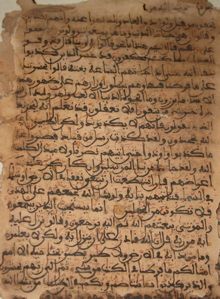
It is impossible to list them all here. But some of the main ones are here in alphabetical order.
The Ahmed Baba Centre is named after the prominent scholar of Timbuktu. Ahmed Baba, already well known and respected in Timbuktu, spent 12 years in exile in Marrakech where he was deported along with many other scholars in 1593 after the Moroccan invasion. He returned in time to live the last year of his life in his beloved city. The centre not only restores and preserves thousands of manuscripts from hundreds of families, it is slowly scanning and digitizing them to make them more available to researchers and eventual translators etc. The centre was created by UNESCO in 1996 when scholars realized Africa did has a written history was well as an oral one.
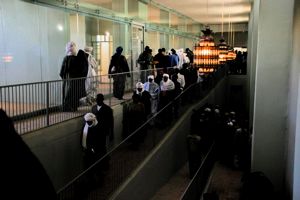
Hours are Mon. - Thurs. 9 a.m. to 4 p.m.
Fri. 9 a.m. to 12:30 and 3 p.m. to 5 p.m.
Sat. 10 a.m. to 1 p.m.
A 1500 fcfa entry fee allows you to look at a display of some ancient manuscripts with accompanying explanation.
The Al Imam Essayouti In the home built by Sidi Mohamed Al-Imam ben Essayouti who lived from 1861 to 1923. He was an important presance in his home town and the entire region. This Soudano-Magrhebin stlye building has been newly refurbished, showing off a classic example of traditional achcitecture. You will find it facing the main entrance to the Djingere Ber mosque. They are cataloguing and digitizing their collection.
Visiting hours are Mon. - Thu. 8 a.m. to 3 p.m.;
Fri. 8am to 12:30 p.m. and 3 p.m. to 5 p.m.
Entry fee is 1000 f cfa. They have some postcards of ancient manuscripts for sale, proceeds go to help maintain the library.
Fondo Kati is another private library with international acclaim, though more connected with Spain. The Fondo Kati counts 3000 manuscripts most of which relate to Andalousie.The manuscripts show how the Almorvidin empire which ones streched to Poitier was also influential in Timbuktu. The collection began in the 1468 when the first Kati ancestor left Toledo in Spain passing through Grenada and Sevile to live the land of the Soninke. It has since increased and been dispersed throughout the region and the various branches of the family. Today the Director Ismael Diadie Haidara has regrouped as many of his family's manuscripts as he can in this library and research centre. The structure itself is an excelent example of Timbuktu's traditional arcitecture The library has two permanent exhibitions. It is located about 30 meters east past the Mama Haidara Library. tel: 21 92 11 27, www.fondacionmahmudkati.org (website is presently only in Spanish)
Visiting hours: Everyday from 8 a.m. to 8 p.m.
Entry Fee: 1500 f CFA. They have a display of postcards and books written by the author for sale to help fund the library. They also have lodging availble for researchers and forms for sponsorship of anyone wishing to contribute to the preservation of the manuscripts.
The Mamma Haidara Library has gained international notice lending some of its works for temporary displays in the USA. It was started in Bama (near Gao) around the 16th century and the collection has passed on from father to son ever since. They have around 9000 manuscripts, of which 2000 have been catalogued. Today it is maintaint in cooperation with Harvard University, the Minister of Culture and the library's owner, Abldel Khader Haidara.
To find it, head east on the street just south of the post office past the hospital and the school. It is on the north side of the road. Managed by Abdel Kader Haidara, it is has a well-presented display of manuscripts and some of paraphernalia for their preparation.
Hours are Mon. - Fri. 8 a.m. to 3 p.m. Mohamed Touré is the librarian who does the visits, if it is after hours you can contact him and he will open up 942 70 84. The library fixed line is 21 92 16 76.
The fee for visiting the exposition is 1500 f CFA they also have some postcards and a large colour booklet for sale as well as a booklet on the history of Timbuktu. Proceeds go to maintain the library.
Mohamed Altay, known as Inej, has collected his family's manuscripts and is attempting to restore them. He lives near the Flamme de la Paix.
The library Muhamed Bagayogo is named after the erudite scholar of the 16th century in whose home it is located. Mohamed ben Mohamoud ben Abou Bakr Bagayogo al-wangari was born in Djenné in 1523. Skilled and virtuous Jurisconsulte he assumed the functions of the imam of the mosque, the cadi of the city and a professure at the university of sankore. He died 7 Jully 1593 and his home situated in Badjindé is an integral part of the ancitent city of Timbutku. He was also the instructor of the renowned Ahmad Baba, who himself studied in the courtyard of this house. It is one of the group of private libraries to receive funding, the building has been recently restored and they are attempting to find the means to digitize and translate their manuscripts so as to make them available to researchers world wide.
Visiting hours are Mon. Thurs. 8 a.m. to 3 p.m.
Fri. & Sat. 8 a.m. to 12 p.m.
The guardian Mohamed Cissé will open and show you around, if you come after hours ask the nieghbours and someone will call him to let you in.
Fee: 1500 f CFA.
Museums
There are two principal museums in town. The first is the municipal museum which has “Buctou’s well” and examples of a Tuareg camp in the yard, as well as a shop selling souvenirs and post cards. This well is suposed to stand at the place of the palace of Mohamed Naddi who was the chief or mayor of the city from 1433-67. The interior offers a staid but informative display of Neolithic artifacts as well as those of the Tuareg and Sognai history. It is located east down the street just south of the Sidi Yahya Mosque. The director is Mama Touré (tel: 76 19 77 42). Hours: Everyday 8 a.m. to 12:30 and 3 p.m. to 6 p.m. Entry fee is 2500 f CFA
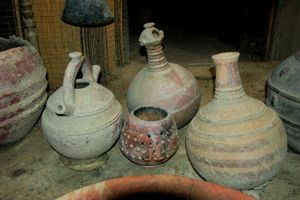
A new museum Musée Arsene Klob,has opened attached to the christian cemetary, between Patiserie Asco and the Military Camp. It is a homage to the French occupation and the colonials burried in the cemetery.
Markets
While there are numerous small market areas scattered around Timbuktu to searve the needs of local families. There are a few major market areas that regroup larger numbers of verdors and a greater varriety of goods.
Yobou Ber, meaning Grande Marché (big market) in Songai, was formerly called Badjindé meaning prefered place of hippopotomi. As the arm of the Niger that reached Timbuktu progressively dried up, the area became a place of trade between the caravaners from the North and the Wangara of sub-Saharan Africa. The main building was built in 1950, then demolished and renovated succesviely in 1966 and in 2003. The structure has been faced with limestone so as to integrate with the local architechture. you can get a good view off the rooftop
Yobou Tawo, or Petit Marché (little market), The permanent construction just behind the Maison des Artisans holds a buchers area and some shops of staple goods. Around the outside mostly women sell groceries: dry goods and perishables rice, millet, fish, fruis, vegtables and spices. Shops nearby sell housewares.
la maison des artisans This house of artisans regroups the several socioprofessional catagories of artisans of Timbuktu. It is a place to meet artist and observe them in action as they engage in their traditional work of forge or loom or laste on the spot. It is also an opertunity to purchase suvenier, knives, jewelery, shoes, leather bags, had woven cloth to name but a few. Of course many artisans still work out of their homes so it is not the only place to find these items. It is, however, the simplest for the tourist in a hurry. The structure was built with finacial suport from Canada and is located accross from the Petit Marché.
Monuments
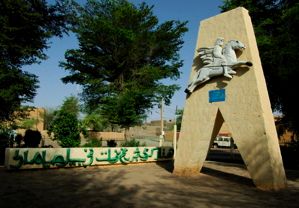
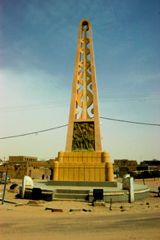
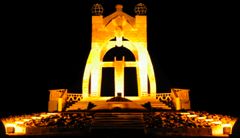
Environmental
Sababou Bangou. Just to the east of the Hotel Buctou Anexe is an odd pit, several levels of terraces reinforced with limestone blocks are now beginning to cave in but it was the site of the only fresh water spring in the area. People had been useing it as a convenient place to dump trash but it has been recently taken in had by the international community: the trash has been removed and a limestone block enclosure with metalstudded doors has served to protect it from further dumping. The posted signs call this the first stage of renovation presumable there are plans to reinforce the teracing etc.
Legend has it that one of the the 333 saints was responsible for its creation. At one time when there was a drought, women of the town went to seek out the guy. They said to him if you claim to be a saint, intervene with God for us so we have rain. He said I never claimed to be a saint, it is you who call me such, but the women wouldn’t let him be so he stamped his staff against the ground and where he stamped it water spurted forth. It was a source of water for a long time, people believing it to have curative properties if drunk or bathed in. It eventually became contaminated but was still used for gardening, successive terraces dug down as water decreased. It dried up completely in 1948, coinciding with the first water towers to be installed in Timbouctou. Or not, the believers say it came to answer and need left because people didn’t need it - or appreciate - it anymore.
The Jardin de la Paix, north past the Flamme de la Paix and the école de la Paix at the extremity of the Quartier de la Paix, this garden is not much to look at. It was constructed as part of the peace building process, but like so much has not been adequately maintained. The walls are broken down in places, buried by sand in others. Animals roam freely, locals chop branches off trees here and there for firewood. Some gardening still takes place, but the pump on the water tower is broken. It is still a nice place to walk for someone looking for some quiet time to meditate.
To see some beautiful dunes. continue north past the garden. This area has the biggest, and most beautiful in the vicinity of Timbuktu. To the south there are lots of cramcrams (horrible tenacious little burrs) to contend with. Here you can sit in peace to watch a beautiful sunset or the herds of goats and sheep coming home in the evening.
The canal that used to run from Koriome to Timbuktu has been dug out and reenforced by the Lybians the canal is now officially named the canal de Koriome but most people call it the canal de Kadafy. The end comes up to the south side of the Azali hotel. walk across the open sandy space from the hotel Bouctou or the Petit Marche towards the cemetaire des trois saintes.

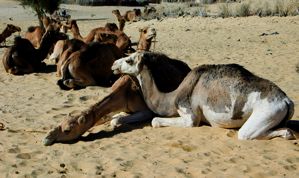
camel ride, followed closely by a night or more in the desert or in a nearby Tuareg camp. You will undoubtedly be approached by many people offering such excursions. The quality of your outing depends on who arranges it. It should be noted that if you arrange with someone who is not actually a Tuareg then that person will subcontract your outing to a real Tuareg as the various sedentary black Africans do not have camels and do not have the culture of the desert. In some cases the people are offering are not even Songai, the black population from the north, but from Mopti, Bamako or even Burkina Faso hoping to profit from the tourist season here. Look for lighter “red” skinned people typically wearing pale blue or white boubous and turbans, although not a fail safe, you are more likely to at least have someone of nomad decent. See more about guides
Another possibility is a day trip on the Niger River. Renting a pinnace for a day to visit some Bozo fishing villages and the Island of the Hippos is an alternative to spending several days coming or going to Mopti or Gao.
If you are more adventurous you could rent a 4x4 here and take a few days to explore the desert or go see the lakes to the west, Lake Fagabine and Fati (though fast drying up) and the tombs of the giants, or a bit of the open spaces to the north.